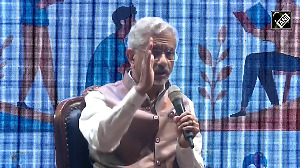The Deshpande Center for Technological Innovation at MIT, that awarded over half a million dollars in Fall 2005 grants last month, has shown that a little help early in the innovation cycle goes a long way towards successful commercialisation of academic and scientific research.
The grant, now in its fourth year, is made possible thanks to a 2001 fund of $20 million donated by Gururaj 'Desh' Deshpande, co-founder of Sycamore Networks and a member of the MIT Corporation Board, and his wife Jaishree.
Recipients of the Fall 2005 grants include Sangeeta N Bhatia of the Health Sciences and Technology/Electrical Engineering and Computer Science, who is working on creation of miniature human liver tissue that could lead to safer, faster, and more cost-effective drug development by measuring toxicity at an early stage in the development process, and Lionel Kimerling and Anu Agarwal, in the Materials Processing and Microphotonics Centers/Department of Materials Science and Engineering, who is working in the field of infrared sensors used for night-vision systems and other applications.
'The grant winners this Fall not only are among the most exciting we've seen, but also will benefit from the success of those who have come before,' said Center Executive Director Krisztina Holly.
'Over the past three years, we have refined our process to provide the most effective support to innovators, starting with hands-on expertise at the very inception of a commercial idea.'
"The idea behind the DCTI is to combine innovation with relevance so that innovation actually achieves some real value, either societal or commercial," Deshpande told rediff India Abroad. "When you create value, then over a course of time the economy benefits because innovation benefits the economy, and also you will create a self-sustaining model where the growth of the economy will foster even more innovation.
"In the next 50 years, there will be a lot of innovations, some of which will be put on the shelf for use later. Instead of that, I am trying to see if we can create a model by which you still have to invent a lot of things, but you will invent them in sequence so that they can create a lot of value."
By way of example, said Deshpande, when one goes to a professor he or she usually has a great idea that coiuld make a difference. "But if you talk to the professor a month later, you will find that he has ten more ideas because that is his business to come up with new ideas.
"The problem is that the professor has no clue as to which of these 10 ideas should be pursued, because what she/he lacks is relevance of the market place and what the world really needs."
This is where DCTI comes in - by sifting through the dozens of ideas, and through judicious funding, attempting to prioritize them in logical sequence, with the most relevant ideas receiving the most immediate funding.
The Center awards two kinds of grants ' Ignition Grants' to research teams that are in the very early stages of determining technical feasibility of breakthrough ideas, and 'Innovation Grants' to teams that have already made significant academic progress but are at the cusp of applying their research to the most promising markets, and determining whether to start a company or pursue a license to commercial partners.
"Traditionally, this has been the point where many research projects have fallen short because of lack of funding, market input, or other support," said Professor Charles Cooney, faculty director of the Deshpande Center.
The Center supports each team with a structured set of programs and referrals to other resources, including assignment of one or more catalysts, opportunities for exposure at events and other activities
Thus, the first time grants given by the Center last week were to teams doing research that could result in new commercial applications ranging from gas masks that neutralize nerve agents, to laboratory-grown human liver cells that test new drugs, to a new material enabling flexible computer displays.
The Center also gave follow-on 'innovation grants' to research teams already exploring ways to commercialise two additional technologies -- a medical imaging process designed to pinpoint tiny cancer tumors, and a multi-spectral infrared array technology that could result in very-low-cost night-vision systems for military and security applications.
The Fall 2005 grants brings to $5.5 million the total funding given to 47 research teams at MIT since the DCTI began its innovation support programs in 2002. They also broaden the range of projects funded by the DCTI, whose mission is to help MIT innovators make a social, economic, and academic difference with their discoveries and inventions.
More than a third of the projects are already in the process of forming independent companies, and nine of them have already raised a total of $36 million, above and beyond their DCTI grant money, in private equity from venture capital firms and angel investors.
Cambridge biotechnology startup Pervasis Therapeutics last month secured $12 million in additional funding from top-tier venture capital firms. Pervasis' journey began in 2002, when a small research team from the laboratories of Professors Elazer Edelman and Robert Langer at MIT won one of the first Deshpande Center grants.
The team used the grant to help demonstrate the possible commercial viability of its research to patients with vascular disease, preparing it for clinical trials.
In addition to the financial support, grant-winners also tap the Deshpande Center's extensive network of 'catalysts' -- volunteers from the business community guiding the projects. This non-financial support, according to MIT, has been a critical factor enabling researchers to navigate the process of identifying target markets, validating commercial feasibility, and recruiting team members.
Like Pervasis, over a third of the 44 teams that have won Deshpande Center grants to date are in the process of forming new companies, raising venture capital, or seeking licensing arrangements with established companies for their innovations.
'Collectively, they are setting a pattern for faster and more efficient commercialization of academic research. They are pointing toward a solution to the 'innovation gap' that has been a cause of frustration and concern not only in the academic world but also to government and private industry,' the Center said.
"The Deshpande Center has a well-defined process to nurture innovation and accelerate the migration of ideas to the commercial marketplace," said Clark Colton, an MIT Professor of Chemical Engineering whose research on targeting and illuminating cancer tumors for MRI scans won an Ignition Grant in 2004 and is being supported with an Innovation Grant in the current round.
"I feel fortunate that the Center was willing to take a chance on our idea a year ago. As we continue reducing the risk of our early-stage research, hands-on support from Deshpande Catalysts has been helping us make connections and clarify the commercial potential of our project," Deshpande said.
"Our original vision for the Deshpande Center for Technological Innovation was to help MIT researchers make a societal, academic and economic difference with their innovations," he added.
"Our programme so far has done well. The success of Pervasis and other startups that have spun out of our grant program demonstrates the enormous leverage the Center has been able to provide at the earliest stages of the innovation cycle, not only through financial assistance but, more importantly, through knowledge, expertise and personal assistance."







 © 2025
© 2025